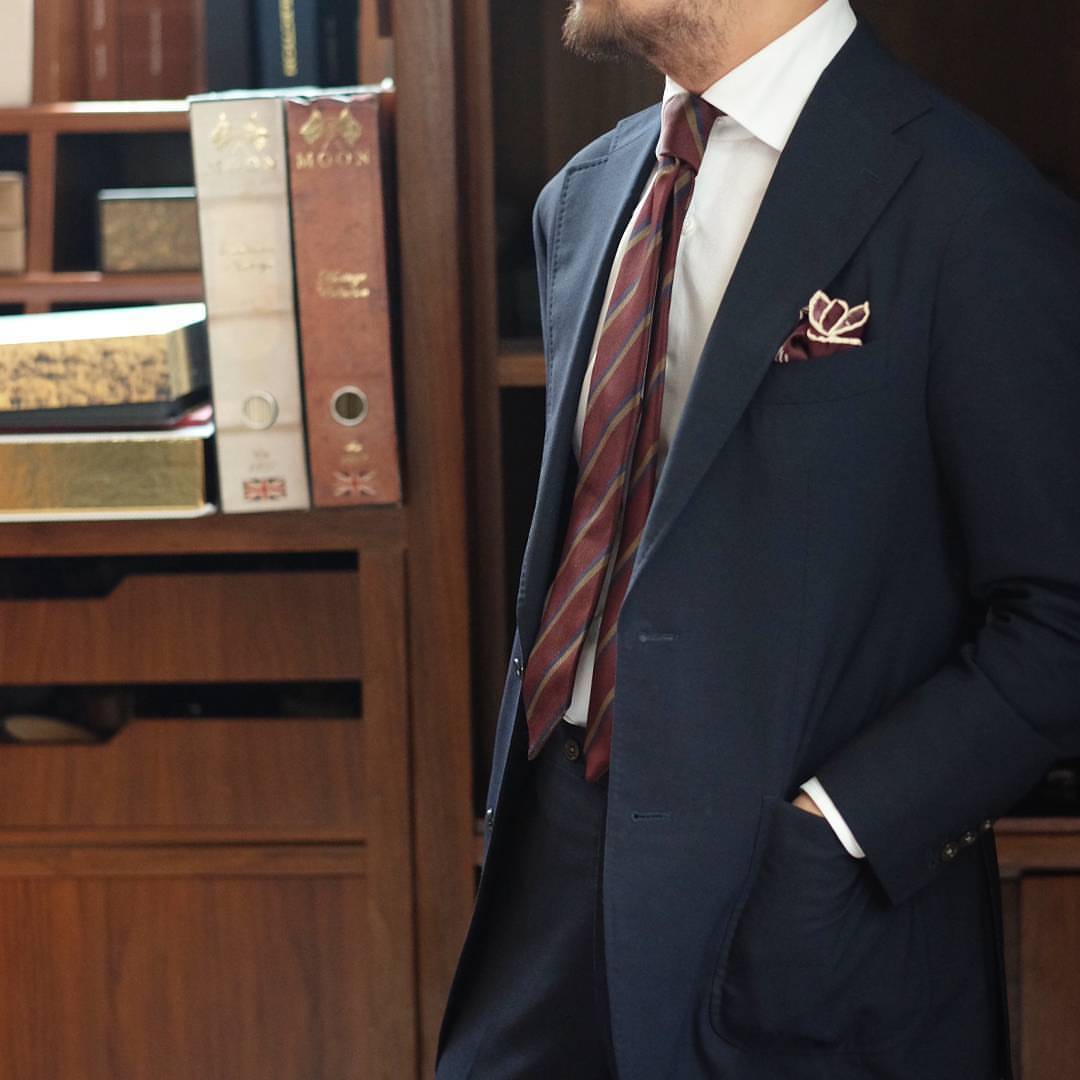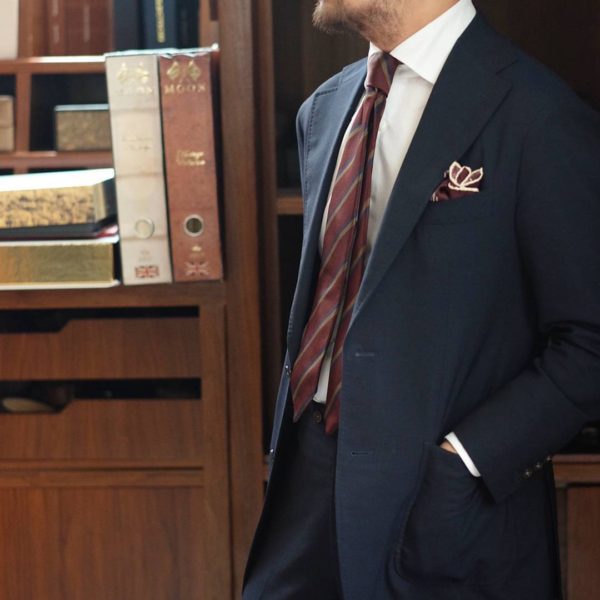
There are a lot of articles about what you should get for your first suit. Maybe more than the number of men who even still wear tailored clothing. Most of them deal with the basics – single vs. double breasted, grey vs. navy, peak vs. notch lapel.
The problem is those articles tell you the language of suits without giving you a better understanding of what to choose. And choice in this case depends greatly on your lifestyle.
If you’re asking what you should get for your first suit, chances are, you don’t wear suits often. If you did, you’d be asking what to get for your first four or five. Guys who wear suits as part of their daily wardrobe need a rotation to get them through the week.
So, the real question is: what should you get for your first suit if you – like many men today – only wear one on special occasions?
As Jesse once said, you need a “sincere suit.” Something to wear to weddings, funerals, job interviews, big presentations, court appearances, etc. It’s the one wardrobe essential you actually ought to have in your closet. And if you want one that won’t make you look like a schmuck, you need to shop for it now, rather than at the last minute.
A Starter Suit for Guys Who Rarely Wear Suits
Here’s the perfect first suit: it’s one that you can break into separates.
If you don’t wear suits often, you might as well be able to wear the jacket as a standalone sport coat (and navy sport coats are tremendously useful). Pair it with grey wool trousers, tan chinos, or even dark denim (I’m skeptical of the denim on tailored clothing look, but it can be done). This is something you can wear to nice restaurants, swanky parties, casual business meetings, or any time you just want to look and feel great. It’s a lot easier to wear a navy sport coat these days than a full suit.
So, how do you get a suit jacket that transitions well into a sport coat?
- Fabric: Unfortunately, there’s a language in fabrics that takes a while to learn, and it’s not always intuitive. Yes, generally speaking, the smoother and silkier the fabric, the more likely it can only be worn as a suit. However, there are also certain patterns and weaves that scream “business” – pinstripes, birdseye, nailhead, sharkskin, etc. You want to avoid those. Instead, get something like a heavier-weight, hopsack wool, which is a chunky plain weave that can pass for either suit or sport coat material. Go for something with a bit of heft to it.
- Color: Navy. Remember, you want this to work as a sport coat, not just a suit jacket. Grey sport coats exist, but they’re a lot harder to wear (and don’t work as easily in double-duty terms).
- Closure: Single breasted, notch lapel. And while I’m at it, I’ll reveal my American bias and say you should opt for a three-roll-two closure. Two buttons are a little sleeker; three-roll-two keeps things professional, but still casual. True-three buttons are rarely flattering.
- Other Details: The key here is to make sure your jacket doesn’t look like an orphaned suit jacket when worn on its own. So, look for details that throw this a little more into sport coat territory (but still allow you to wear this as part of a dark, conservative suit). Examples: patch pockets at the hips (good); patch pocket at the breast (bad, as you’re now probably taking this a step too far); soft shoulders (good); brass buttons (bad, as you’re again taking this too far); pick stitching or double-stitched edges (good); contrast-colored buttonholes (always bad, regardless).
See the photo above for a good example: a dark navy suit with swelled edges on the lapels, patch pockets at the hips, and soft shoulders. Worn with matching trousers, everyone would understand this to be a suit. Worn without the trousers, however, and you have a perfectly functional sport coat. Not true if you were to get a silkier, navy birdseye suit with jetted pockets. Or a charcoal pinstripe. Or a grey sharkskin. Etc etc etc.
The Downsides?
This sort of suit isn’t without its downsides. For someone with an experienced eye, such casual details will look a little odd on a business suit. And if you work on Wall Street or at a conservative office, you may raise a few eyebrows.
Most people, however, can wear this sort of thing without anyone blinking. Yes, you’ll have a suit that’s neither fish nor fowl – not sleek enough to be a true business suit, maybe not casual enough to be your ideal sport coat. However, for the kind of guy who doesn’t wear suits often, this is a way to make sure you don’t drop $1,000+ on something you’ll break out once in a blue moon. A navy sport coat is infinitely more versatile in today’s age, and this allows you to get a little more mileage out of your purchase.
Plus, few people today understand the language of suits so well that they’ll notice patch pockets on your suit jacket (on the rare occasion you’ll even wear one). If you’re around such people, my guess is that you’re the kind of guy who wears suits as part of his daily uniform (so you’re not just shopping for one suit).
The other downside? You’ll probably have to drop a little more money. It’s hard, although not impossible, to find these things on the lower-end of the price spectrum. If you have a little more coin to spend, here are some options to consider:
- Sartoria Formosa: A Neapolitan tailoring house with a wonderful cut. Slightly extended shoulders and comfortably full chest, paired with a nipped waist. No Man Walks Alone has one of their suits in a navy Fresco, which can be worn in all but the coldest of winters. You can also custom order a Formosa suit in any fabric and design details once you know your size.
- Ring Jacket: A popular, Japanese company that specializes in softer, slightly more casual-looking constructions. The Armoury calls this 4-ply wool model their “core suit” because it works so easily year-round. The cloth has a heft and springiness to it, as well as a slightly open weave (although it can work in most climates). See it here as a suit and here as a sport coat. Like with Formosa, once you know your Ring Jacket size, you can place custom orders to get whatever details you want.
- Orazio Luciano: Another Neapolitan tailoring house, this one with slightly bolder detailing than Formosa. Gentlemen’s Footwear in San Diego has their sport coat as standard in hopsack (you would just need to order matching pants, which they can provide). Or you can place an MTO order through the shop (they can take remote orders if you’re not local).
- Kent Wang: Remote made-to-measure. We don’t typically recommend such things because self-measuring for a suit or sport coat is notoriously difficult (although workable for shirts). Kent, however, has a program where he sends you a stock suit that you can try on, which you then modify from there (thus taking some of the guesswork out). Like the other options above, you can custom order something here in any fabric. Possibly a good option for readers looking for a more affordable buy.
The other option: shop local, thrift, and hunt for deals – but look for details that allow you to wear the jacket on its own. That’ll make for a solid first suit for guys who just don’t wear suits all too often.
(photo via The Armoury)








